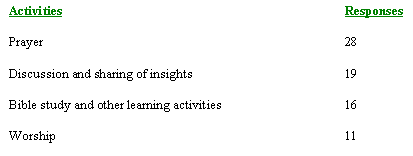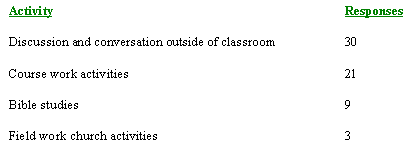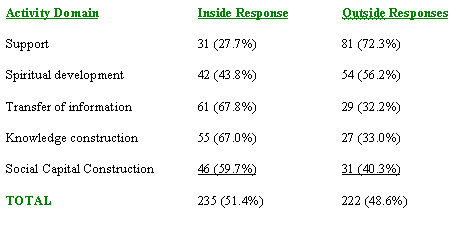The current paper builds on Reports #34 and 35 in this series, which discussed the use of collaborative software to develop online communities in distance education (DE). The paper illustrates the manner in which an educational community's needs should be carefully examined, in the process of designing techniques that fulfill these needs at a distance. Student perceptions of their theological education community at Concordia Seminary, St. Louis, Missouri (http://www.csl.edu/Home.html) are investigated, via a survey instrument designed to define the students' communal needs.
Introduction
Distance education (DE) is still, at best, a fledgling enterprise among higher theological education institutions. Even though DE inroads are being made at some theological schools, the programs involved are usually small and restricted to the needs of students who cannot come to campus for “the real thing”. Most theological educators still view DE as an inferior form of education compared with face-to-face (F2F) studies. They typically present several reasons for their slow adoption of DE, but perhaps the most common and most forcefully stated reason centers around issues of community. Theological education involves much more than the mere transfer of information, and seeks to establish a modeling/ mentoring relationship that takes place within a theological community. There, theological thinking, reasoning, and lifestyle are modeled, students daily engage in “water cooler” discussion and debates, and theology involves the engagement of one's personal being and the transfer of an entire culture and belief structure. These activities have traditionally involved close F2F contact between students and faculty, and theological educators have resisted DE because they contend that the rich traditional, environment cannot be reproduced in a distance setting.
This argument against DE, however, is based on several, often unstated assumptions. The first assumption is that a community must be spatially situated, and defined in fixed physical terms (e.g., by village or neighborhood, or campus boundaries). Since the advent of inexpensive travel and long-distance communication technologies, however, personal communities have expanded beyond spatial boundaries, and include people who live far apart. A second assumption is that campus communities are by definition closely-knit. This may have been true when most theology students were single and lived on campus. In that environment, students lived, ate, played, and studied together in an intensive community experience. The experience of many theological campuses today, however, is quite different. Many seminary students are married with children, come from previous careers, and live and work away from campus. It should not be assumed that locality does not play an important role in their community experience. The campus is still the central meeting place where many student activities take place. But students now have busy lives filled with activities that take place off campus, and their situation complicates the task of creating supportive campus-based, student communities.
The current project is based on the belief that DE techniques may be useful means to compensate for the relative estrangement of modern-day campus life. The study aims to discover and describe the theological education community from the students' perspective, and to provide theological educators with an accurate description of the meaning of the communities to which they cater. It is hoped that, supplied with this description of the theological community, educators will be better equipped to make decisions relating to residential and DE aspects of theological programming. Specifically, the project will address the question: “How do residential theological students of Concordia Seminary perceive their community?” To answer this question, the following questions are asked:
Q1. Who are members of a student's community?
Q2. What activities do the students regard as primary in their community?
Q3. Where do activities within a student's community occur?
Q4. How satisfied are students with their community?
Method
Concordia Seminary in St. Louis Missouri, has 538 students enrolled in the Master of Divinity program (MDiv), which prepares students for ordination and pastoral work. The residential students who participated in the study are all male and in the 2nd year or 4th year of the program. The average age of the student population is 30 years. Fifty percent of the students are in their second career, and 57percent are married. The specific sample investigated comprises 21 full-time, residential MDiv students. Two professors were randomly chosen and asked if they would allow the researcher to talk with their students. Both professors granted this p'rmission, and offered the students the possibility of participating in the study. Thirty-seven surveys were distributed, of which 21 were completed and returned.
Results
Q1. Who are members of a student's community? Five community member categories were identified:
- The single largest community member category is that of Church/ Pastor,
yielding 108 responses out of a total of 457 responses (23.6 percent). This
category consists of all churches with which the student has a relationship
- e.g., a home church, or fieldwork churches in which students work during
their residential studies.
- The second largest category is that of Professor, yielding 76 responses
(10.1 percent). Some survey participants did not use Professor as a
category, but chose to use Classes as a category. Classes recorded
25 responses (5.5 percent). When Professor and Classes categories
are combined, there are 101 responses (22.1 percent).
- The third category is that of Friend, with 64 responses (14 percent).
- The fourth is that of Spouse/Family, with 49 responses (10.7 percent).
- The fifth is that of Group, with 29 responses (6.3 percent).
Q2. What theological education activities do students regard as primary in their community?
a) Support: The most frequently mentioned activities in which survey participants receive support are:
b) Theological Education Spiritual Development: The most frequently mentioned activities in which participants find their spiritual lives strengthened are:

c) Information Transfer: The most frequently mentioned activities in which participants transfer information are:

d) Knowledge Construction: The most frequently mentioned activities in which participants construct knowledge are:

e) Social Capital Construction: The most frequently mentioned activities in which participants construct social capital are:

Q3. Where do activities within a student's community occur?
The primary purpose of this question is to identify whether or not students perceive their community activities as taking place inside or outside of the seminary structure. All activities that take place as a direct result of the student's activities at Concordia Seminary are considered as inside the seminary structure. All activities that are not a direct result of the student's work at Concordia Seminary are considered as being outside the seminary structure.

These responses indicate that community activities are split approximately 50/ 50 between activities that occur inside and outside of the seminary structure. Support activities, primarily financial aid and encouragement, predominantly take place outside the seminary structure. Spiritual development activities are also seen by students as taking place predominantly outside the seminary community. Activities associated with the transfer of information and the construction of knowledge are perceived as primarily occurring inside the seminary community. The construction of social capital is mainly taking place within the seminary structure, with a strong minority of social capital building activities (40 percent) taking place outside it.
Q4. How satisfied are students with their community?
This question attempts to identify the theological student's general level of satisfaction with his educational community's ability to satisfy his needs in each activity area. Evidently, students feel that their theological education community is doing a good-to-excellent job in satisfying their needs. They perceive that the community performs at its best in meeting their material and non-material needs, and that it is weakest in the area of constructing knowledge (though this satisfaction level is nonetheless strong. The cumulative responses to questions in this category were as follows, where agreement indicates satisfaction:

Discussion of Results
The results indicate that they seminary students perceive themselves to be well supported in all activity aspects of their community life, and that their communities are diverse and widely distributed inside and outside the seminary. Not surprisingly, the professor and the classroom play a major role in the theological education community. The professors and their classes are by far the leading context in which students acquire information, and the classroom is the leading context in which students transform information into knowledge. In the current study, however, seminarians identified the classroom context as only the third major community setting in which their spiritual formation takes place; and a striking finding is the prominent role of external church congregations in the students' community life. Students perceive congregations (including home and fieldwork communities associated with the MDiv program) as the primary community provider of material and non-material support, and of opportunities for spiritual development. Congregations are perceived as comparable with formal classroom tuition in relation to knowledge construction, and are identified as the second largest community provider in the transfer of information. The data indicate that students use their work and interactions within congregations as their primary platform for testing and validating the information that they receive in the classroom. This testing and validation process is a crucial step in transforming raw classroom data and information into knowledge, and in transferring the knowledge to other settings.
It is also evident that congregations are an important venue in which students obtain new information and spiritual development. This is not a traditional view in theological education. Evidently, when supervising seminarians' fieldwork, pastors take time to interact with them. The students greatly value these interactions, and it makes a significant impact on them. This impact comes in the form of either new information or the adaptation and adoption of classroom information into the seminarian's cognitive structures. Conversely, students who come from home and fieldwork congregations where interaction between the seminarian and the pastor is lacking, do not experience such a rich theological education community as is evident in the congregations where such interaction is common. This raises questions of work overload in fieldwork congregations which have a large number of seminarians. Numerous other conclusions are possible from the data as a whole, and those relating specifically to DE implications of the study will be stressed by this report.
Implications for Distance-Based Theological Education
‘Church' could be simply changed to ‘Society,” or, in the case of a corporate educational program, to ‘Acme Corporation!'
Conclusions
Societal changes in the United States commonly raise the question of whether or not the theological education community has deteriorated. The current survey, however, has indicated that the theological education community of Concordia Seminary, St. Louis is alive and well. It is diverse and distributed, taking place in the classroom, the home, and local congregations. Outside congregations, both local and distant, support students with material and non-material needs and with opportunities for spiritual growth. These same congregations also play an important role in the transfer of information, and the construction of knowledge and social capital. Although improvements could be made in its design and sample size, and more information could be collected about the students' demographics, the survey has generated suggestive findings about the future viability of DE approaches in meeting the needs of the distributed communities in which today's theological students are active.
Author
John Palka is an instructional systems designer for the Ethnic Immigrant Institute of Theology, Concordia Seminary, St. Louis, MO (see http://www.csl.edu/EIIT.htm).
———————————————————————
The next report in the series discusses an online approach to marriage mentorship.
N.B. Owing to the speed with which Web addresses become outdated, online references are not cited in this report. They are available, together with updates to the current report, at the Athabasca University software evaluation site: http://cde.athabascau.ca/softeval/. The report is also featured in the ConferReview archive of http://www.conferzone.com/. Italicized product names in this report can be assumed to be registered industrial or trademarks.
JPB Series Editor, Technical Evaluation Reports.
